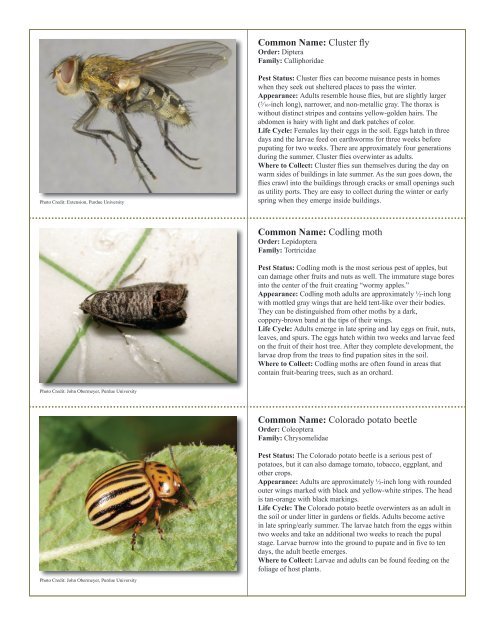to download pdf - Purdue Extension Entomology - Purdue University
to download pdf - Purdue Extension Entomology - Purdue University
to download pdf - Purdue Extension Entomology - Purdue University
You also want an ePaper? Increase the reach of your titles
YUMPU automatically turns print PDFs into web optimized ePapers that Google loves.
Common Name: Cluster fly<br />
Order: Diptera<br />
Family: Calliphoridae<br />
Pho<strong>to</strong> Credit: <strong>Extension</strong>, <strong>Purdue</strong> <strong>University</strong><br />
Pest Status: Cluster flies can become nuisance pests in homes<br />
when they seek out sheltered places <strong>to</strong> pass the winter.<br />
Appearance: Adults resemble house flies, but are slightly larger<br />
( 5 ⁄16-inch long), narrower, and non-metallic gray. The thorax is<br />
without distinct stripes and contains yellow-golden hairs. The<br />
abdomen is hairy with light and dark patches of color.<br />
Life Cycle: Females lay their eggs in the soil. Eggs hatch in three<br />
days and the larvae feed on earthworms for three weeks before<br />
pupating for two weeks. There are approximately four generations<br />
during the summer. Cluster flies overwinter as adults.<br />
Where <strong>to</strong> Collect: Cluster flies sun themselves during the day on<br />
warm sides of buildings in late summer. As the sun goes down, the<br />
flies crawl in<strong>to</strong> the buildings through cracks or small openings such<br />
as utility ports. They are easy <strong>to</strong> collect during the winter or early<br />
spring when they emerge inside buildings.<br />
Common Name: Codling moth<br />
Order: Lepidoptera<br />
Family: Tortricidae<br />
Pest Status: Codling moth is the most serious pest of apples, but<br />
can damage other fruits and nuts as well. The immature stage bores<br />
in<strong>to</strong> the center of the fruit creating “wormy apples.”<br />
Appearance: Codling moth adults are approximately ½-inch long<br />
with mottled gray wings that are held tent-like over their bodies.<br />
They can be distinguished from other moths by a dark,<br />
coppery-brown band at the tips of their wings.<br />
Life Cycle: Adults emerge in late spring and lay eggs on fruit, nuts,<br />
leaves, and spurs. The eggs hatch within two weeks and larvae feed<br />
on the fruit of their host tree. After they complete development, the<br />
larvae drop from the trees <strong>to</strong> find pupation sites in the soil.<br />
Where <strong>to</strong> Collect: Codling moths are often found in areas that<br />
contain fruit-bearing trees, such as an orchard.<br />
Pho<strong>to</strong> Credit: John Obermeyer, <strong>Purdue</strong> <strong>University</strong><br />
Common Name: Colorado pota<strong>to</strong> beetle<br />
Order: Coleoptera<br />
Family: Chrysomelidae<br />
Pest Status: The Colorado pota<strong>to</strong> beetle is a serious pest of<br />
pota<strong>to</strong>es, but it can also damage <strong>to</strong>ma<strong>to</strong>, <strong>to</strong>bacco, eggplant, and<br />
other crops.<br />
Appearance: Adults are approximately ½-inch long with rounded<br />
outer wings marked with black and yellow-white stripes. The head<br />
is tan-orange with black markings.<br />
Life Cycle: The Colorado pota<strong>to</strong> beetle overwinters as an adult in<br />
the soil or under litter in gardens or fields. Adults become active<br />
in late spring/early summer. The larvae hatch from the eggs within<br />
two weeks and take an additional two weeks <strong>to</strong> reach the pupal<br />
stage. Larvae burrow in<strong>to</strong> the ground <strong>to</strong> pupate and in five <strong>to</strong> ten<br />
days, the adult beetle emerges.<br />
Where <strong>to</strong> Collect: Larvae and adults can be found feeding on the<br />
foliage of host plants.<br />
Pho<strong>to</strong> Credit: John Obermeyer, <strong>Purdue</strong> <strong>University</strong>
















